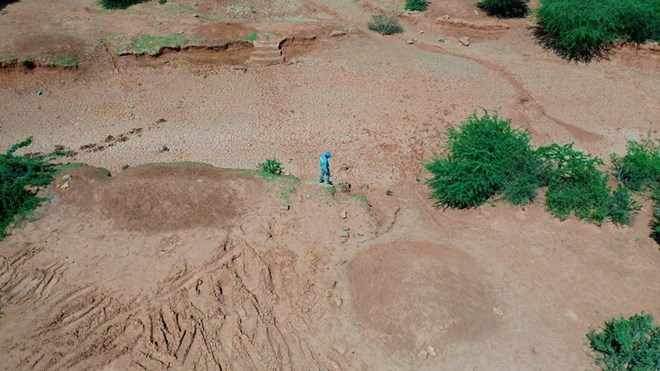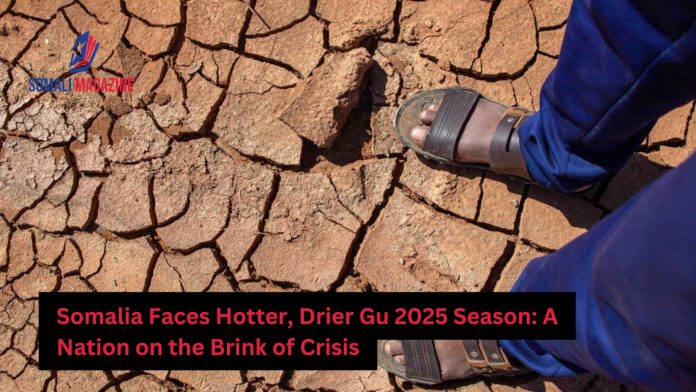Facebook Twitter Instagram Somali Magazine - People's Magazine
Somalia is preparing for a challenging Gu season (March-May 2025) as forecasts predict hotter and drier-than-usual conditions across much of the country. The anticipated weather patterns, revealed during the sixth National Climate Outlook Forum (NCOF6) held in Mogadishu, pose significant risks to food security, water availability, and livestock survival, exacerbating an already dire humanitarian situation.
The seasonal outlook, developed with input from the Ministry of Environment and Climate Change (MoECC), the Food and Agriculture Organization (FAO), and the Intergovernmental Authority on Development Climate Prediction and Applications Centre (ICPAC), paints a grim picture. Below-average rainfall is expected in key regions, including Gedo, Hiraan, Middle Shabelle, Bakool, Bay, and parts of Galguduud and Mudug. These areas face a more than 50% likelihood of drier-than-normal conditions, while above-average temperatures are anticipated nationwide, with some regions seeing a 60% probability of exceeding seasonal norms.
The delayed onset of rainfall, coupled with prolonged dry spells, is expected to intensify drought conditions. Rainfall is projected to begin as late as April 24 in some regions, with the longest wet spells occurring between April 20 and May 11 in coastal areas like Lower Juba and Puntland. These erratic patterns threaten Somalia’s agricultural output, a critical lifeline for millions of people. Crops are likely to fail, water sources may dwindle, and livestock—an essential source of income for rural families—could face devastating losses.
The implications of these forecasts are far-reaching. Somalia, already grappling with the aftermath of consecutive failed rainy seasons, is at heightened risk of food insecurity. According to the latest Integrated Food Security Phase Classification (IPC) analysis, 4.4 million people—nearly a quarter of the population—could face crisis levels of hunger (IPC Phase 3 or higher) between April and June 2025. This marks a sharp increase from the 3.4 million people currently experiencing acute hunger. Among those most affected are internally displaced persons (IDPs), pastoralists with limited livestock, and farming households that have exhausted their food supplies.

The humanitarian toll is expected to be severe, with 1.7 million children under five projected to suffer from acute malnutrition in 2025, including 466,000 cases of severe acute malnutrition. Southern Somalia, where drought conditions are most extreme, accounts for nearly two-thirds of these cases. The combination of food shortages, water scarcity, and rising temperatures also raises the risk of waterborne diseases and heat-related illnesses, further straining the country’s fragile healthcare system.
To mitigate the looming crisis, Somali authorities and humanitarian agencies are calling for urgent action. The NCOF6 forum emphasized the need to strengthen early warning systems, scale up drought response efforts, and support at-risk communities. Farmers and livestock keepers are being urged to adopt climate-resilient practices, such as water conservation techniques and drought-tolerant crops. Health and disaster management authorities are preparing for potential outbreaks of diseases like malaria and cholera, while development partners and NGOs are mobilizing resources to provide timely humanitarian assistance.
The international community has been urged to step up funding and support for Somalia’s humanitarian response. The country’s 2025 Humanitarian Needs and Response Plan, which requires $1.42 billion, remains critically underfunded, with only 12.4% of the required amount secured. Without adequate resources, aid agencies warn that the situation could deteriorate rapidly, pushing millions deeper into crisis.
As Somalia braces for the Gu 2025 season, the focus remains on building resilience and addressing the root causes of vulnerability. The challenges ahead are immense, but with coordinated efforts and timely interventions, there is hope for mitigating the worst impacts of this climate crisis.

